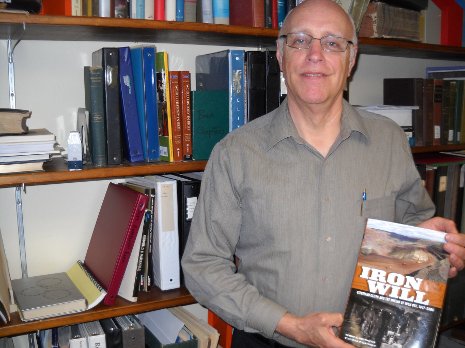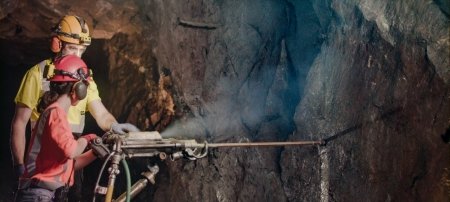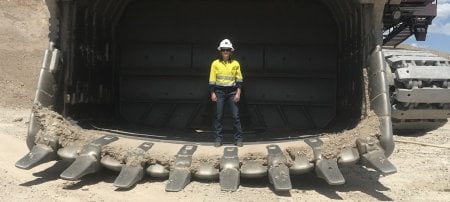Scholar Coauthors Book on Mining Company, Marquette Iron Range

Upper Michigan is dotted with population centers associated with mining: from Iron River and Iron Mountain to Copper City and Copper Harbor. The region’s copper legacy has been well documented, the iron legacy less so. Now comes a lode of information on Upper Michigan’s iron ore industry—a story told in part by a Michigan Technological University scholar.
The new book, published by Wayne State University Press, is titled Iron Will: Cleveland-Cliffs And The Mining of Iron Ore, 1847–2006. The authors are Terry Reynolds, a professor of social sciences at Michigan Tech, and Virginia Dawson, an independent researcher from Ohio.
They have fashioned a chronicle about the start, rise, decline and survival of a company that was one of the region’s earliest iron ore mining firms—one among a dozen large producers.
The business, founded in 1847, was initially called the Cleveland Iron Mining Co. It became Cleveland-Cliffs in 1890, when it absorbed a long-time rival and became the most important producer on the Marquette iron range. It is now Cliffs Natural Resources.
The authors assert that the book’s title, “Iron Will,” captures the company’s “resilience in the face of panics, depressions, strikes, technical bottlenecks and bankrupt partners.” Twice the company weathered a collapse of its backbone, the steel industry, most recently in 2001.
According to one scholar, this account is “a major contribution to the literature on Lake Superior metal mining and the best book on the Marquette iron range in many decades.” Indeed, there have been several popular histories of the firm, but this is first scholarly study of the Michigan iron industry in more than 100 years.
Reynolds came to Tech in 1983. He served as chair of the Department of Social Sciences from 1990 to 2002. He stepped down from those duties to get back to teaching and research. A renowned scholar and prolific author. Reynolds' focus is the history of technology. He has written three other books in the field and has edited another three.
He and Dawson organized their saga around five themes:
• Sound management: Early-on, one leader was described as having “the courage to venture where favoring opportunity led the way.” A father-son team, Samuel and William Mather, led the company for nearly a century and provided continuity that most of its rivals could not match.
• Ore depletion: An evergreen tree, situated on the top of the ore in a railcar, marked the first shipment of ore from a new mine; a broom announced the last shipment. This ritual was “repeated many times during the first 100 years of operation.” In the 1950s, the company responded to the depletion of rich ores by developing a process of enriching the more abundant lean ores. The switch saved the firm.
• The cyclical nature of the business: The iron and steel industry has traditionally been plagued by periods of boom and bust. “Every economic upheaval . . . buffeted the iron ore industry.” Survival strategies: acquisitions and partnerships.
• Labor relations: They ranged from amicable to contentious.
• Technology: Iron ore sells by the ton and relies on cheap, bulk transportation to markets throughout the Midwest. Reynolds says of the scenario, “If you can’t transport iron ore cheaply, it’s worthless.” With the building of ore docks in Marquette, 15 miles of rail service from Ishpeming to the Marquette harbor and the opening of the Soo Locks in 1855, it became possible to earn a profit. With regard to technology, Cleveland Cliffs was sometimes a copycat, sometimes an innovator.
Reynolds and Dawson divvied up the workload on the book. He focused on the period 1847 to 1950; she wrote about 1960 to present. They combined efforts on the decade between. He concentrated on the technical aspects in Upper Michigan; she focused on the business operations in Cleveland.
Reynolds examined a variety of historical records, principally those at the Northern Michigan University Archives, which houses “vast volumes of materials” on Cleveland-Cliffs. He started researching in spring 2003 while on sabbatical; he completed the final draft in 2009 while on leave.
The biggest challenge, Reynolds says, was staying focused on the mining, for the company also had extensive interests in timber, lake shipping, wood products and land sales.
The company wanted a scholarly history of Michigan’s iron ore industry, so it funded the project. The authors had a free hand. Reynolds explains, “We didn’t want the company looking over us all the time, and they didn’t want a puff piece. So they left us alone.”
The publication process proved rigorous. Reynolds says it’s “a relief” to have it done. “One thing about writing a book,” he says, “it keeps coming back at you.” He is referring to reviews, revisions and indexing. “You give birth to the same baby two or three times.”
If it was a hard labor, it also was a important one. Upper Michigan’s copper industry is long gone, but the iron industry persists. The firm that became Cleveland-Cliffs started with a toehold in the Upper Michigan wilds. Today, it is the only surviving independent mining company in the US focused on iron ore and the country’s leading producer of iron ore pellets. Now its reach is far, with operations in the US, Canada, Australia and Brazil. The authors call that the company’s survival over more than 160 years—a period marked by alternating prosperity and struggle—simply “remarkable.”
Michigan Technological University is an R1 public research university founded in 1885 in Houghton, and is home to nearly 7,500 students from more than 60 countries around the world. Consistently ranked among the best universities in the country for return on investment, Michigan's flagship technological university offers more than 185 undergraduate and graduate degree programs in science and technology, engineering, computing, forestry, business, health professions, humanities, mathematics, social sciences, and the arts. The rural campus is situated just miles from Lake Superior in Michigan's Upper Peninsula, offering year-round opportunities for outdoor adventure.




Comments